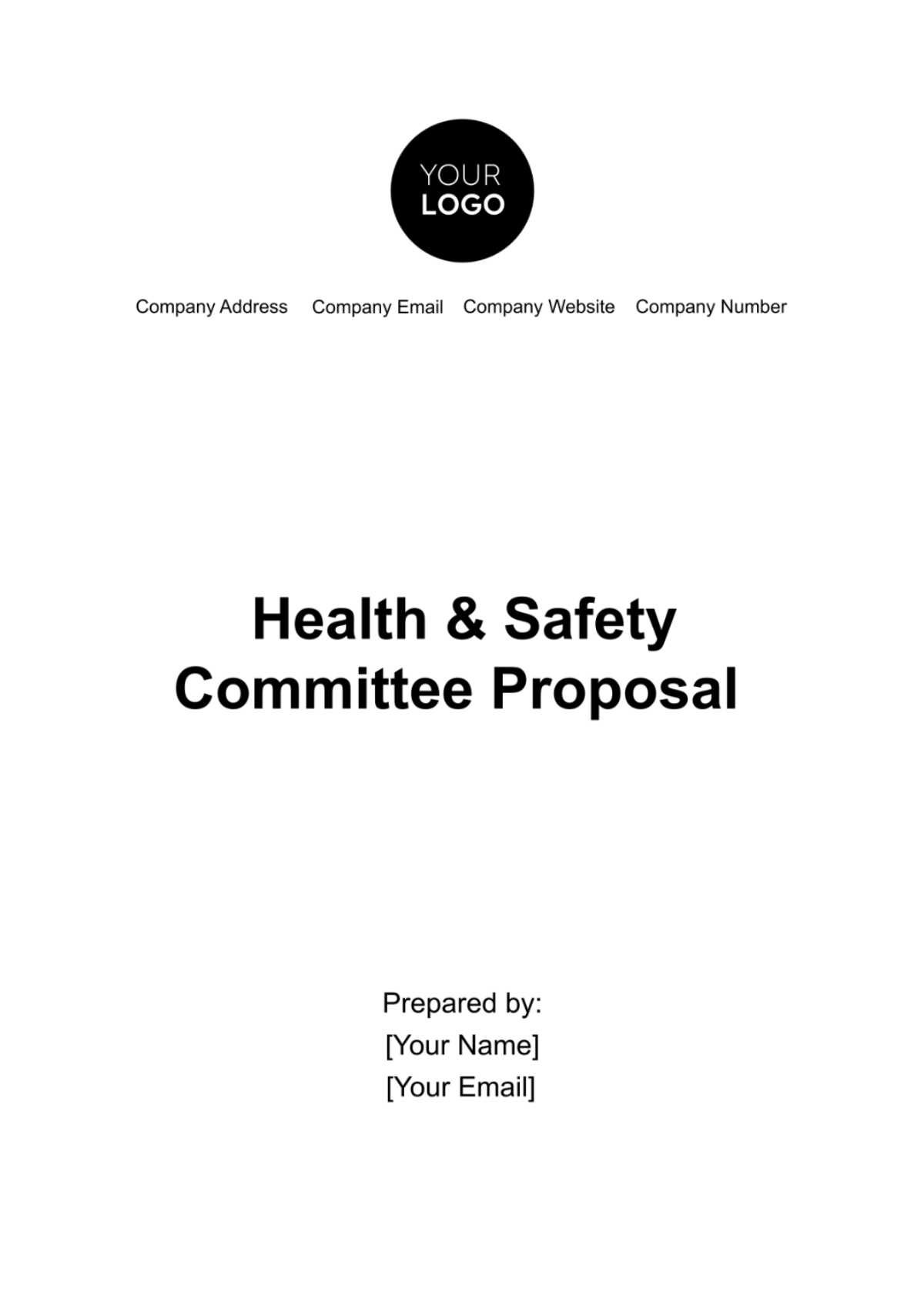Free Health & Safety Committee Proposal

Introduction
Purpose of the Proposal
The primary aim of this proposal is to establish a Health & Safety Committee within our organization. This initiative is rooted in our commitment to fostering a safe and healthy work environment for all employees. In recent times, the importance of workplace safety has become more prominent, and it is imperative that we proactively address this need. The committee will serve as the driving force in identifying, managing, and mitigating health and safety risks, ensuring compliance with regulations, and promoting a culture of safety awareness throughout the company.
Key objectives include:
Developing and enforcing robust health and safety policies.
Conducting regular risk assessments and implementing necessary changes.
Providing training and development opportunities for employees.
Regularly monitoring and evaluating health and safety practices.
This proposal outlines the structure, roles, and operations of the proposed Health & Safety Committee, offering a strategic approach to achieving these objectives.
Committee Formation
Selection Criteria
To ensure a diverse and competent Health & Safety Committee, the selection criteria are based on the following:
Criteria | Description |
Departmental Representation | Members from various departments including operations, HR, finance, and technical teams. |
Member Roles and Responsibilities
The committee will consist of the following roles, each with distinct responsibilities:
Role | Responsibilities |
Chairperson | Lead the committee, set agendas, and ensure follow-up on action items. |
Committee Operations
Meeting Schedule
The committee will convene according to the following schedule:
Meeting Type | Frequency | Duration | Time |
Regular Meeting | [Monthly] | [1 Hour] | [10:00 AM - 11:00 AM] |
Communication Plan
A structured communication plan is vital for the effectiveness of the committee:
Communication Type | Method | Frequency | Purpose |
Internal Updates | Email & Intranet | Bi-weekly | Update staff on committee activities and safety tips. |
This operation plan ensures regular and effective functioning of the Health & Safety Committee, promoting a safe and informed workplace environment.
Health & Safety Policies
Review and Development
The committee will undertake a comprehensive review of existing health and safety policies and develop new ones as necessary. The process includes:
1. Initial Review Phase: Analyze current policies against industry standards and legal requirements.
2. Employee Feedback: Gather input from employees through surveys and focus groups to understand their safety concerns.
3. Policy Development: Draft new policies or revise existing ones based on the gathered data and feedback.
4. Approval and Implementation: Present the policies to the management for approval and then implement them across the organization.
The timeline for this process is as follows:
Phase | Duration | Key Activities |
Initial Review | [1 Month] | Review existing policies, benchmark against standards. |
Implementation Strategies
The implementation of new health and safety policies will involve:
1. Training Sessions: Conducting comprehensive training programs to educate employees about the new policies.
2. Awareness Campaigns: Launching awareness campaigns using posters, emails, and intranet updates.
3. Monitoring Systems: Establishing monitoring mechanisms to ensure adherence to the policies.
Risk Assessment and Management
Risk Identification Process
The committee will systematically identify potential health and safety risks using the following process:
1. Hazard Identification: Identify hazards in the workplace through inspections and employee feedback.
2. Risk Analysis: Assess the potential impact and likelihood of each identified hazard.
The process is detailed in the table below:
Step | Method | Responsible Party |
Hazard Identification | Workplace inspections, Employee surveys | Safety Officer, General Members |
Mitigation Plans
For each identified risk, the committee will develop a specific mitigation plan. Key components include:
1. Emergency Response Procedures: Establishing and regularly updating emergency response plans for different types of incidents.
2. Regular Drills: Conducting drills to ensure preparedness for emergencies like fires, earthquakes, etc.
3. Preventive Measures: Implementing preventive measures such as safety equipment, signage, and regular maintenance checks.
Each mitigation plan is documented in a standardized format, as shown below:
Risk Category | Mitigation Strategy | Implementation Timeline | Responsible Party |
Fire Risk | Installation of fire alarms and extinguishers, regular fire drills | [3 Months] | Facilities Manager |
By systematically reviewing and updating health & safety policies and proactively managing risks, the committee aims to create a safer and healthier work environment for all employees.
Training and Development
Training Programs
The committee will implement a series of training programs designed to enhance employee awareness and skills in health and safety. The programs include:
1. Basic Health & Safety Orientation: This foundational course is mandatory for all new employees, providing them with essential knowledge about basic safety protocols and emergency response procedures. It serves as an integral part of our onboarding process, ensuring every team member starts with a solid understanding of workplace safety.
2. Advanced Safety Training: Tailored for personnel in roles with increased exposure to risk, this advanced training delves into specific hazards pertinent to their duties. The focus is on detailed hazard recognition, risk assessment, and the implementation of advanced prevention and mitigation strategies.
3. First Aid and CPR Training: Through regular training sessions, we aim to develop a robust network of first-aid certified employees across all departments. This initiative emphasizes the importance of immediate and effective response to health emergencies, enhancing overall workplace safety.
4. Emergency Response Drills: We will conduct frequent emergency response drills to simulate a variety of critical situations, including fires, earthquakes, and security breaches. These drills are designed to test and refine our emergency response protocols, ensuring preparedness and swift action in real-world scenarios.
The training schedule and details are outlined in the table below:
Training Program | Target Audience | Frequency | Duration |
Basic Health & Safety Orientation | All new hires | As needed | 2 Hours |
Development Opportunities
To encourage continuous learning and development in health and safety, the committee will provide:
1. Workshops and Seminars: We will organize frequent, in-depth workshops focusing on a variety of health and safety subjects. These sessions will be conducted by distinguished experts in the field, ensuring high-quality, up-to-date information and practical insights.
2. Certification Courses: Members will have the chance to participate in accredited health and safety certification courses. To support this endeavor, the organization may offer sponsorship or financial assistance, underscoring our commitment to professional growth in this critical area.
3. Online Learning Modules: We will provide access to an extensive selection of online learning modules. These resources will cater to self-directed learning, allowing members to enhance their knowledge and skills at their own pace and convenience.
Monitoring and Evaluation
Performance Metrics
The committee will use the following key performance indicators (KPIs) to monitor the effectiveness of health and safety initiatives:
KPI | Description |
Incident Rate | The frequency of accidents and incidents in the workplace. |
Evaluation Schedule
Regular evaluations will be conducted to assess the effectiveness of the committee’s activities and the overall health and safety environment:
Evaluation Type | Frequency | Method |
Policy Review | Annually | Review of current policies against incidents and feedback. |
By diligently implementing these training and development initiatives and rigorously monitoring and evaluating their effectiveness, the Health & Safety Committee aims to foster a culture of safety and continuous improvement within the organization.
Conclusion
The formation of the Health & Safety Committee is a crucial step towards reinforcing our organization's commitment to creating a safe and healthy workplace. Through the diligent efforts of this committee, we anticipate significant improvements in our health and safety standards. The proposed structure and operations of the committee are designed to ensure comprehensive coverage of all aspects of workplace safety, from policy development to risk management, training, and continuous monitoring and evaluation.
- 100% Customizable, free editor
- Access 1 Million+ Templates, photo’s & graphics
- Download or share as a template
- Click and replace photos, graphics, text, backgrounds
- Resize, crop, AI write & more
- Access advanced editor
Craft persuasive proposals for health and safety initiatives with Template.net's Health & Safety Committee Proposal Template. Editable and customizable, this template aids in presenting well-structured proposals for establishing or enhancing health and safety committees. Essential for workplace safety advocates, it outlines objectives, strategies, and benefits to garner support and approval effectively.
You may also like
- Business Proposal
- Research Proposal
- Proposal Request
- Project Proposal
- Grant Proposal
- Photography Proposal
- Job Proposal
- Budget Proposal
- Marketing Proposal
- Branding Proposal
- Advertising Proposal
- Sales Proposal
- Startup Proposal
- Event Proposal
- Creative Proposal
- Restaurant Proposal
- Blank Proposal
- One Page Proposal
- Proposal Report
- IT Proposal
- Non Profit Proposal
- Training Proposal
- Construction Proposal
- School Proposal
- Cleaning Proposal
- Contract Proposal
- HR Proposal
- Travel Agency Proposal
- Small Business Proposal
- Investment Proposal
- Bid Proposal
- Retail Business Proposal
- Sponsorship Proposal
- Academic Proposal
- Partnership Proposal
- Work Proposal
- Agency Proposal
- University Proposal
- Accounting Proposal
- Real Estate Proposal
- Hotel Proposal
- Product Proposal
- Advertising Agency Proposal
- Development Proposal
- Loan Proposal
- Website Proposal
- Nursing Home Proposal
- Financial Proposal
- Salon Proposal
- Freelancer Proposal
- Funding Proposal
- Work from Home Proposal
- Company Proposal
- Consulting Proposal
- Educational Proposal
- Construction Bid Proposal
- Interior Design Proposal
- New Product Proposal
- Sports Proposal
- Corporate Proposal
- Food Proposal
- Property Proposal
- Maintenance Proposal
- Purchase Proposal
- Rental Proposal
- Recruitment Proposal
- Social Media Proposal
- Travel Proposal
- Trip Proposal
- Software Proposal
- Conference Proposal
- Graphic Design Proposal
- Law Firm Proposal
- Medical Proposal
- Music Proposal
- Pricing Proposal
- SEO Proposal
- Strategy Proposal
- Technical Proposal
- Coaching Proposal
- Ecommerce Proposal
- Fundraising Proposal
- Landscaping Proposal
- Charity Proposal
- Contractor Proposal
- Exhibition Proposal
- Art Proposal
- Mobile Proposal
- Equipment Proposal
- Student Proposal
- Engineering Proposal
- Business Proposal





























